WHAT'S NEW ACROSS THE WORLD
| What's New ©by
Laif DeMason
The long, hot summer is finally over and the kids
are back at school. The extreme heat waves experienced by many are a reminder
to all of us to have a back up system and plan for our fish. Hopefully
you did not have any losses from high heat and power outages in your aquaria
this summer! Interestingly, fish farms are reporting better than normal
sales this summer. Perhaps, hobbyists have spent more time inside avoiding
the heat and working in their fish tanks. Or, maybe there are fewer commercial
breeders (the number tends to be cyclical in nature) and, thus, less producers
to buy fish from. The number of exporters and importers has certainly not
decreased. Whatever the reason, fish purveyors are smiling. Hopefully this
will continue and the recent changes in air travel will not adversely affect
the shipping of tropical fishes.
Here’s “what’s new” on the cichlid scene: |
Lake Tanganyika
Exports continue to flow from all points on Lake Tanganyika, with most
material being collected in Burundi, Tanzania and Zambia. Infrequent collections
from Congo are ongoing. Hobbyists are seeking the “ultimate” in exclusive
fishes and the not-often-seen items. Popular species seem to be new featherfin
varieties, such as Ophthalmotilapia and Cyathopharnyx, along
with any fish that is not normally available. Many of the more challenging
fishes to keep and breed, such as Petrochromis species, are also sought.
|
what's new: Lake Tanganyika
|

Often sold as Cyprichromis microlepidotus,
this C. pavo was photographed near Kasanga, Tanzania. Photo by A.
Konings. |

Also collected in Tanzania, from Kerenge Island near
Kipili, Xenotilapia sp. “papilio sunflower” is infrequently available. |
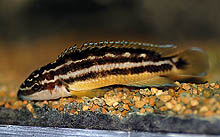
Collected in northern Congo, this Julidochromis
ornatus Bemba is a rare export. |
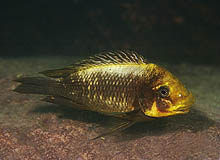
Several species of Petrochromis are quite popular
as of late; here, P. ephippium from Kantalamba, Tanzania. Photo
by A. Konings. |
Lake Malawi
Malawi cichlids are still are favored by many fish hobbyists. New converts
seem to be joining the ranks regularly. A new trend for US hobbyists is
the purchase of wild breeders or F1 young to start out with. The old motivation
of price rather than quality has faded. The pedigree of wild strain characteristics
is now more important than cost. At the other extreme, “designer” names
and strains for varieties not associated with wild stocks have also flourished.
Aulonocara varieties with new names are big leaders in this regard.

Exported from northern Malawi, Petrotilapia
sp. “chitimba” often exhibits pleasing wide barring and is usually very
territorial. |

Imported from Malawi two years ago, this fish is sold
as Dimidiochromis dimidiatus, yet may prove to be a different and
unknown species. |

Collected from Gallireya Reef, Malawi, and sold as
Metriaclima sp. “long pelvic hara zebra,” this new “zebra”-type
sports interesting coloration. |

Exported only in dribbles, Mylochromis cf.
sphaerodon from Tanzania is now available from bred sources. Females
and juveniles exhibit bright yellow-orange ventral fins. |
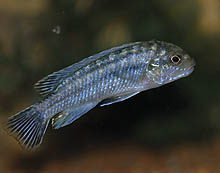
Several species of small mbuna remain popular. Pictured
here, and often sold as Labidochromis flavigulis, L. strigatus is
one of them. |
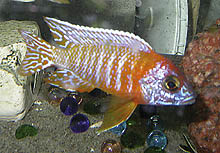
One of the newer man-made varieties, Aulonocara
“Strawberry” is not known nor collected from the wild. |
Lake Victoria
No news of wild-collected material continues to disappoint Victorian
cichlids fans. The only current sources for any of these fishes are a handful
of breeders. Often, new-comers in the African cichlid hobby do not have
any reliable way comparing the fish they purchase with wild fish. Reputable
web sites can often help with identification needs.
|
what's new: Lake Victoria
|

Originally from conservation programs and released
to hobbyists years ago, Haplochromis (Prognathochromis) perrieri may
be difficult to find now. Photo by P. Loiselle. |

Still bred by the Haplochromis Study Group in Leiden,
Netherlands, Haplochromis (Pundamilia) nyererei Makobe is very colorful
in its wild form. Photo by O. Seehausen. |
West Africa
Export companies in the typical West African countries have grown over
the last year, indicating that interest and demand may have increased for
these species. Many hobbyists still hope that each shipment from their
importers will contain the seasonal gems they long for. However, the normal
export fare is usually what arrives in each consignment. The best bet is
to contact breeders who specialize in the fishes you seek.

The cave-spawning Thysochromis ansorgii can
be found from private breeders and in commercial shipments from Nigeria.
Females, like the one pictured here, exhibit a shiny patch above their
vent. Photo by A. Bornstein. |

A welcome export from Guinea, Pelmatochromis buettikoferi
is marked with orange, yellow, and green. The trademark “pelmato”-spot
migrates downwards as the fish ages. Here, an adult female. Photo by A.
Bornstein. |
Neotropics
Most South American countries report brisk exports as the collecting
season enters full-swing. Brazil is still struggling with problems in their
airline industry. Breeders still produce a large variety of species and
remain critical to the supply chain.
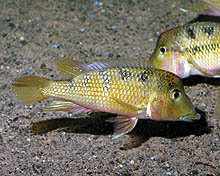
Rarely exported, and hailing from Panama, Geophagus
crassilabris is similar to G. steindachneri but grows much larger.
Photo by O. Lucanus. |

Originally from the Rio Madeira area in Brazil, Apistogramma
pulchra sports a bright orange tail fin and is related to A. agassizi.
Photo by O. Lucanus. |
|















